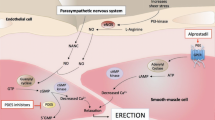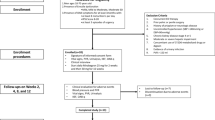Abstract
The aim of this study was to evaluate the clinical outcomes of patients in acute phase of Peyronie’s disease (PD) treated with daily low-dose of Tadalafil. An observational retrospective study involving patients in acute phase of PD with erectile dysfunction (ED) was designed. All subjects were offered Tadalafil 5 mg one tablet a day. Men who accepted treatment were compared to patients who refused Tadalafil. Penile curvature progression was chosen as the primary outcome. PD Questionnaire (PDQ) and IIEF-5 scores were selected as secondary outcomes. A total of 191 patients were included in the study (108 intervention vs. 83 control). Penile curvature progression rate was significantly lower in subjects taking Tadalafil at 12 weeks (25.9% vs. 39.7%, p = 0.042). Mean IIEF-5 score improved in the intervention group, becoming significantly higher compared to the observation group at 12 weeks (19.3 vs. 11.2 points, p < 0.001). Mean PDQ-Overall and PDQ-Penile Pain scores only improved in the intervention group and the statistically significant differences at baseline between groups became not statistically significant at 12 weeks (p = 0.001 vs. p = 0.232 and p < 0.001 vs. p = 0.078, respectively). Daily low-dose Tadalafil in patients with acute phase of PD seems to significantly reduce the penile curvature progression rate compared to observation, especially when it is administrated early. It also appears to improve erectile function and PD-related symptoms.
This is a preview of subscription content, access via your institution
Access options
Subscribe to this journal
Receive 8 print issues and online access
$259.00 per year
only $32.38 per issue
Buy this article
- Purchase on Springer Link
- Instant access to full article PDF
Prices may be subject to local taxes which are calculated during checkout

Similar content being viewed by others
Data availability
Raw data is available if requested.
References
Miner MM, Seftel AD. Peyronie’s disease: epidemiology, diagnosis, and management. Curr Med Res Opin. 2014;30:113–20.
Piraino J, Chaudhary H, Ames K, Okoye F 3rd, Sterling M, Clavell-Hernandez J, et al. A consistent lack of consistency in defining the acute and chronic phases of Peyronie’s disease: a review of the contemporary literature. Sex Med Rev. 2022;10:698–713.
Punjani N, Nascimento B, Salter C, Miranda E, Terrier J, Taniguchi H, et al. Predictors of Depression in Men With Peyronie’s Disease Seeking Evaluation. J Sex Med. 2021;18:783–8.
Mulhall JP, Schiff J, Guhring P. An Analysis of the Natural History of Peyronie’s Disease. J Urol. 2006;175:2115–8.
Weidner W, Schroeder-Printzen I, Weiske WH, Vosshenrich R. Sexual Dysfunction in Peyronie’s Disease: An Analysis of 222 Patients Without Previous Local Plaque Therapy. J Urol. 1997;157:325–8.
Salonia A, Bettocchi C, Boeri L, Capogrosso P, Carvalho J, Cilesiz NC, et al. European Association of Urology Guidelines on Sexual and Reproductive Health—2021 Update: Male Sexual Dysfunction. Eur Urol. 2021;80:333–57.
Fernández-Pascual E, Manfredi C, Cocci A, Quintana Franco LM, Egui Rojo MA, Carballido Rodríguez J, et al. A Novel Penile Splint as Early Traction Therapy After Grafting Techniques for Peyronie’s Disease. J Sex Med. 2020;17:1819–24.
Manfredi C, Arcaniolo D, Amicuzi U, Spirito L, Napolitano L, Crocerossa F, et al. Impact of extracorporeal shockwave therapy for erectile dysfunction and Peyronie’s disease on reproductive and hormonal testicular function. Andrology. 2022; https://doi.org/10.1111/andr.13240.
Ferguson JE 3rd, Carson CC 3rd. Phosphodiesterase type 5 inhibitors as a treatment for erectile dysfunction: Current information and new horizons. Arab J Urol. 2013;11:222–9.
Gonzalez-Cadavid NF, Rajfer J. Laboratory Forum: Experimental Models of Peyronie’s Disease. Implications for New Therapies. J Sex Med. 2009;6:303–13.
Chung E, DeYoung L, Brock GB. The Role of PDE5 Inhibitors in Penile Septal Scar Remodeling: Assessment of Clinical and Radiological Outcomes. J Sex Med. 2011;8:1472–7.
Ozturk U, Yesil S, Goktug HNG, Gucuk A, Tuygun C, Sener NC, et al. Effects of sildena fil treatment on patients with Peyronie’s disease and erectile dysfunction. Ir J Med Sci. 2014;183:449–53.
Porst H, Burri A. Current Strategies in the Management of Peyronie’s Disease (PD)—Results of a Survey of 401 Sexual Medicine Experts Across Europe. J Sex Med. 2019;16:901–8.
Teloken K. Medical Management of Peyronie’s Disease: Review of the Clinical Evidence. Med Sci. 2019;7:96.
World Medical Association Declaration of Helsinki: Ethical Principles for Medical Research Involving Human Subjects. JAMA.2013;310:2191.
Rhoden EL, Telöken C, Sogari PR, Vargas Souto CA. The use of the simplified International Index of Erectile Function (IIEF-5) as a diagnostic tool to study the prevalence of erectile dysfunction. Int J Impot Res. 2002;14:245–50.
Hellstrom WJ, Feldman R, Rosen RC, Smith T, Kaufman G, Tursi J. Bother and distress associated with Peyronie’s disease: validation of the Peyronie’s disease questionnaire. J Urol. 2013;190:627–34.
Mulhall JP, Goldstein I, Bushmakin AG, Cappelleri JC, Hvidsten K. Validation of the erection hardness score. J Sex Med. 2007;4:1626–34.
Aslam M. Introducing Kolmogorov–Smirnov Tests under Uncertainty: An Application to Radioactive Data. ACS Omega. 2020;5:914–7.
Kim HY. Statistical notes for clinical researchers: Chi-squared test and Fisher’s exact test. Restor Dent Endod. 2017;42:152.
Vardi Y, Levine LA, Chen J, Hatzimouratidis K, Sohn M. Is there a place for conservative treatment in Peyronie’s disease? J Sex Med. 2009;6:903–9.
Levine LA, Latchamsetty KC. Treatment of erectile dysfunction in patients with Peyronie’s disease using sildenafil citrate. Int J Impot Res. 2002;14:478–82.
Ferrini MG, Vernet D, Magee TR, Shahed A, Qian A, Rajfer J, et al. Antifibrotic Role of Inducible Nitric Oxide Synthase. Nitric Oxide. 2002;6:283–94.
Valente EGA, Vernet D, Ferrini MG, Qian A, Rajfer J, Gonzalez-Cadavid NF. l-Arginine and phosphodiesterase (PDE) inhibitors counteract fibrosis in the Peyronie’s fibrotic plaque and related fibroblast cultures. Nitric Oxide. 2003;9:229–44.
Palmieri A, Imbimbo C, Creta M, Verze P, Fusco F, Mirone V. Tadalafil once daily and extracorporeal shock wave therapy in the management of patients with Peyronie’s disease and erectile dysfunction: results from a prospective randomized trial: ESWT and Tadalafil in PD patients. Int J Androl. 2012;35:190–5.
Dell′Atti L. Tadalafil once daily and intralesional verapamil injection: A new therapeutic direction in Peyronie′s disease. Urol Ann. 2015;7:345.
Hatampour M, Sohrabi K, Mazdak H, Ghadimi K, Salehi H, Kazemi R. Evaluating the efficacy of intraplaque injection of dexamethasone with oral tadalafil in the chordee patients with Peyronie disease. Am J Clin Exp Urol. 2022;10:25–30.
Gong W, Yan M, Chen J, Chaugai S, Chen C, Wang D. Chronic inhibition of cyclic guanosine monophosphate-specific phosphodiesterase 5 prevented cardiac fibrosis through inhibition of transforming growth factor β-induced Smad signaling. Front Med. 2014;8:445–55.
Ilg MM, Stafford SJ, Mateus M, Bustin SA, Carpenter MJ, Muneer A, et al. Phosphodiesterase Type 5 Inhibitors and Selective Estrogen Receptor Modulators Can Prevent But Not Reverse Myofibroblast Transformation in Peyronie’s Disease. J Sex Med. 2020;17:1848–64.
Gonzalez-Cadavid NF, Rajfer J. The two phases of the clinical validation of preclinical translational mechanistic research on PDE5 inhibitors since Viagra’s advent. A personal perspective. Int J Impot Res. 2019;31:57–60.
Garaffa G, Trost LW, Serefoglu EC, Ralph D, Hellstrom WJG. Understanding the course of Peyronie’s disease. Int J Clin Pr. 2013;67:781–8.
Pryor JP, Ralph DJ. Clinical presentations of Peyronie’s disease. Int J Impot Res. 2002;14:414–7.
Verze P, Capece M, Creta M, La Rocca R, Persico F, Spirito L, et al. Efficacy and safety of low-intensity shockwave therapy plus tadalafil 5 mg once daily in men with type 2 diabetes mellitus and erectile dysfunction: a matched-pair comparison study. Asian J Androl. 2020;22:379.
Author information
Authors and Affiliations
Contributions
Conceptualization: LS, CM; Data Collection: RLR, LN, ADA, MC; Data analysis: FT, CS; Writing-original draft: LS, CM; Scientific review: IS; Supervision: MC, DA.
Corresponding author
Ethics declarations
Competing interests
The authors declare no competing interests.
Additional information
Publisher’s note Springer Nature remains neutral with regard to jurisdictional claims in published maps and institutional affiliations.
Rights and permissions
Springer Nature or its licensor (e.g. a society or other partner) holds exclusive rights to this article under a publishing agreement with the author(s) or other rightsholder(s); author self-archiving of the accepted manuscript version of this article is solely governed by the terms of such publishing agreement and applicable law.
About this article
Cite this article
Spirito, L., Manfredi, C., La Rocca, R. et al. Daily low-dose tadalafil may reduce the penile curvature progression rate in patients with acute Peyronie’s disease: a retrospective comparative analysis. Int J Impot Res 36, 129–134 (2024). https://doi.org/10.1038/s41443-022-00651-8
Received:
Revised:
Accepted:
Published:
Issue Date:
DOI: https://doi.org/10.1038/s41443-022-00651-8
This article is cited by
-
Response to: “Commentary on: phosphodiesterase type 5 inhibitors do not prevent curvature progression but shorten pain duration in the active phase of Peyronie’s disease: a retrospective cohort study”
International Journal of Impotence Research (2024)
-
Is there a new role for oral therapy to treat peyronie’s disease? Commentary on Daily low-dose tadalafil may reduce the penile curvature progression rate in patients with acute Peyronie’s Disease: a retrospective comparative analysis
International Journal of Impotence Research (2024)
-
Phosphodiesterase type 5 inhibitors do not prevent curvature progression but shorten pain duration in the active phase of Peyronie’s Disease: A retrospective cohort study
International Journal of Impotence Research (2024)
-
Unveiling treatment horizons and contemporary perspectives in Peyronie’s disease – take home messages from Laurance A. Levine special issue
International Journal of Impotence Research (2024)
-
Long-term outcomes of extracorporeal shock wave therapy for acute Peyronie’s disease: a 10-year retrospective analysis
International Journal of Impotence Research (2024)



